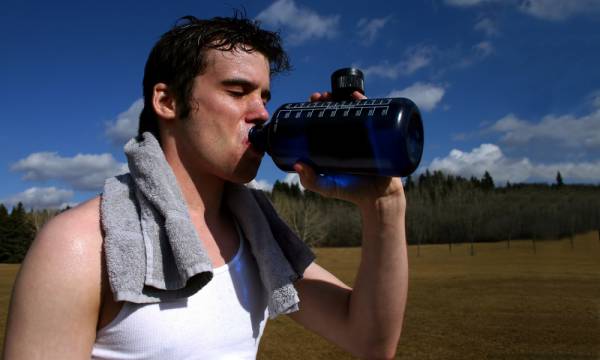1. You Eat the Wrong Foods or You’re on a “Diet”
Real food doesn’t come in a box, have a shelf life, or have ingredients you can’t pronounce. If you’re on a diet that advocates lots of packaged foods, just stop what your doing. Diets don’t work. Remember, losing weight isn’t the goal – keeping it off is.
Dieting can also sabotage your work in the weight room. I’ve seen a lot of clients over the years who thought they could train hard on 1,000 calories a day. Human beings don’t live well (or long) on 1,000 daily calories, and they certainly don’t exercise optimally without proper fuel. And no, your “slow metabolism” isn’t an exception to that rule. Start eating the right things in the right amounts and you’ll realize the best way past a slow metabolism is to stoke the fire, not smother it. Food is your fuel. Feed the engine well.
2. You Aren’t Getting Uncomfortable
If you always exercise with a smile on your face, you probably aren’t getting the results you want. I enjoy my workouts, but I know the only way to get more athletic and keep the body I want involves doing things I don’t necessarily love. Specifically, training anaerobically delivers the results most of us want, enhanced muscle definition and more calories burned at rest.
Anaerobic means training without oxygen. I don’t know the last time you tried not breathing, but it’s not super comfortable. Let’s face it, running sprints like your life depends on it is not fun, and you most likely won’t do it with a smile on your face. But doing the hard and uncomfortable training is where we achieve our best outcomes. You can keep doing your same cardio routine with the same result, or you can train anaerobically and burn more calories both exercising and at rest. Start getting uncomfortable.
3. You’re Not Lifting Heavy
“I don’t want to bulk up,” someone will retort when I encourage him or her to lift heavy. First off, no one accidentally bulks up. Bulking up takes precise training, and just because you switch from a five-pound dumbbell to a ten-pound dumbbell, you aren’t going to bulk up. And there’s no such thing as “toning” either. There is just muscle, and having more muscle equals a faster metabolism. Once again, you can keep doing the same cardio routine and get the same result – or you can lift heavier weights, put on a couple of pounds of lean muscle tissue, and start burning more calories at rest. Start lifting heavy.
4. You Don’t Hydrate
Nothing leads to exhaustion more quickly than not fueling properly – and a huge part of fueling is water. 75% of your muscle tissue and 10% of your fat tissue is comprised of water, so it’s important to replenish water frequently. Factor in variables such as intensity of exercise and temperature, and your body needs water every ten to twenty minutes during exercise. Many athletes use a timer on their watch to remind them to stay hydrated, and so should you.

5. You Drink Too Much Alcohol
In case you haven’t noticed, it’s fashionable to drink. It’s en vogue to open a bottle of wine at the end of day and alcohol has become very much a delicacy. The problem is delicacies are meant to be treats, like desserts. If you eat two desserts every day, the odds are you’re overweight. The same goes with alcohol.
Far be it from me to tell you when and how much you should drink, but if you’re dissatisfied with your fitness level or your body, you can either drink two glasses of wine every day or have the body you want – but not both. Alcohol is an empty calorie, meaning it’s a simple sugar and is metabolized in the body as fat. Alcohol can also interfere with recovery and other variables involved in your exercise performance. Save the delicacies for the cheat days and the weekend.
6. You Wear Worn Out or Incorrect Shoes
Any time someone complains about low-level pain from impact-related activities like running, the first thing I look at is his or her shoes. If you’re going to invest in a gym membership, a trainer, or a fitness program, you should also invest in the right gear. If your shoes are more than six months old, save them for yard work on Saturdays. And make sure you have the right shoe for you. Do your feet pronate or supinate? Do you have a short running stride? Do you know? Go to a specialized running shoe store and have your gait examined. Start wearing the right shoes for the right activities to maximize your results and save yourself from winding up on the sidelines.
7. You Don’t Take Rest, Maintenance or Recovery
If you exercise a lot and don’t prepare your body properly, then you’re walking on thin ice. Rest and maintenance are key – that means things like stretching, myofascial release, and down time. Keeping your body flexible, injury free, and rested is necessary for optimal performance. If you aren’t getting the results you want, look to what you’re doing to maintain and recover your body.
8. You’re Only Active Three Days per Week
I am a big advocate for rest, and believe you should not repeat the same exercise patterns daily, but make no mistake – the human body is meant to move. You should be doing something physically active every day, whether it’s traditional exercise or not. For overall health, the American Heart Association recommends a minimum of five days a week of at least thirty minutes of moderate intensity aerobic exercise. Additionally they recommend at least two days a week of muscle strengthening activity.That’s pretty much every day. Get moving.

9. You Do the Same Exercise Routine Every Time
Who are you, Bill Murray in Groundhog Day? Stop doing the same routine every time at the gym. Assuming you have a fitness or a body composition goal (and who doesn’t?), you’re not going to get there by simply repeating the same patterns. Our bodies acclimate to whatever we throw at them. Do what you love first, and then get out of your comfort zone to do something different. We grow through change.
10. You Set Unrealistic Goals
In my twenties, I wanted to put on twenty pounds of muscle and looked like a linebacker – but I don’t have the natural body of a linebacker. I got up to 175lbs on a frame built to carry 155, only to tear my rotator cuff from overloading my shoulder. Many of us hold ourselves to unrealistic expectations. We desire to look like a picture in a magazine when many of the models in those magazines don’t even share the likeness of their airbrushed photos. Identify your body and athletic type and work to be the best with what you’ve naturally got.
References:
1. “American Heart Association Recommendations for Physical Activity in Adults,” American Heart Association.
Photos courtesy of Shutterstock.






